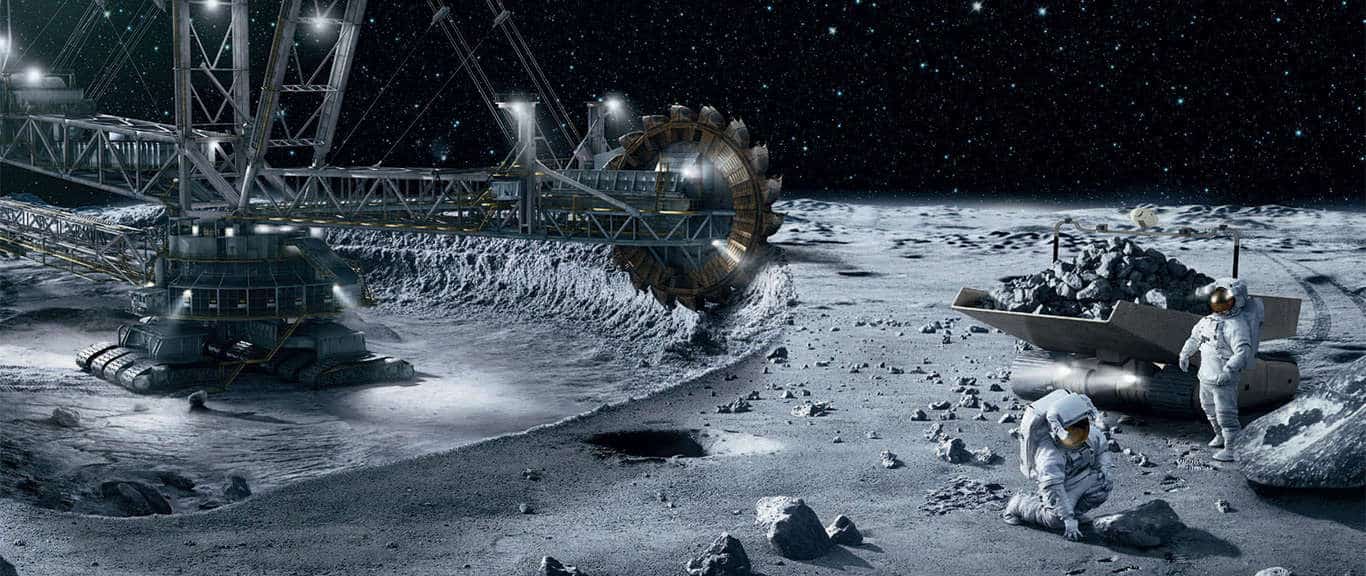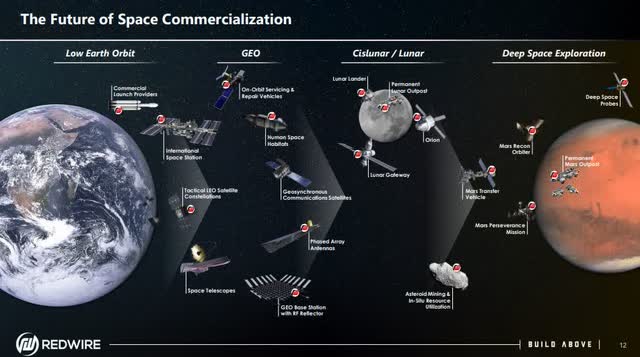White House Cislunar Tech Strategy Part 2 - National Economic Spacepower
How does the 2022 White House Cislunar Science & Technology (S&T) Strategy use and grow national economic spacepower? Read and find out!

How does the 2022 White House Cislunar Science & Technology (S&T) Strategy use and grow national economic spacepower? In a previous article (Part 1) the strategy was reviewed with specific attention to national diplomatic spacepower, one of the four instruments of national spacepower. This article does the same for national economic spacepower. In this article we find that:
The White House National Cislunar S&T Strategy articulates approaches to meaningfully grow national economic spacepower in Cislunar space. Specific focus is placed on necessary conditions such as human capital and Cislunar infrastructure. Resource utilization and commercial partnerships are given as means to increase economic spacepower and prosperity. Several proposed endeavors blend economic and diplomatic spacepower to the benefit, cooperation, and peaceful coexistence of the international community.
In our journey to arrive at these conclusions lets discuss the National Cislunar S&T Strategy 1) impacts on diplomatic spacepower, 2) implications for national economic spacepower, and 3) complementary efforts between national economic and diplomatic spacepower in Cislunar space.
Alea iacta est.
1) A Summary of National Diplomatic and Information Spacepower Impacts
The 2022 White House National Cislunar S&T Strategy lays out key strategy elements of national diplomatic and information spacepower. A previous article gives a much more in-depth review of principal threads than the summary below.
- The Sanctuary School of spacepower theory is promoted. Peaceful uses of space as outlined in the 1967 Outer Space Treaty and Artemis Accords are emphasized for Cislunar regions.
- A rules based international order is endorsed. Continuation of international norms of behavior and institutions such as the United Nations are explicitly supported for Cislunar space.
- Terrestrially-centered space safety and sustainability efforts should be extended to and include Cislunar space. The strategy places high value on setting and demonstrating sustainable norms of behavior and space traffic management.
- International collaboration on planetary defense, space weather, spaceflight safety, and astronomy. Leading and collaborating with international efforts in science and astronautics technology development is a strong theme in the strategy.
- Investigation of long-term human space habitation ethics and governance. The Cislunar strategy proposes asking and answering several fundamental and most important questions for humanity's future.
Another thread focused in national information spacepower is Objective #3 in the Cislunar S&T Strategy. Space Situational (Domain) Awareness (SSA / SDA) is emphasized as a foundational enabling capability for all other forms of national spacepower. The strategy emphasizes developing and deploying enabling technology and infrastructure for SSA / SDA in Cislunar space.
2) National Economic Spacepower Implications
Workforce Development
The strategy calls out technical space workforce development as a necessary effort.
"Develop and support programs to train and retain diverse future generations of the space workforce." (pg. 9, National Cislunar S&T Strategy )
Development of human capital related to space is a necessary component of national economic spacepower. The strategy goes on to emphasize:
"The successful execution of the bold yet critical objectives in Cislunar space requires an expanded and advanced technical workforce." (pg. 9, National Cislunar S&T Strategy)

These arguments are very similar to statements made by the United States Space Force (USSF):
"National spacepower requires explorers, diplomats, entrepreneurs, scientists, developers, and warfighters." (pg. 48, Spacepower - Doctrine for Space Forces)
In a previous article the author expanded on some of these characteristics and their long time-support from classical seapower theorist A. T. Mahan:
Mahan identified national cultural characteristics that lead to these trade-based expansions. They include a nations tendency to trade, financial risk-taking, and initiative for independent action.
Common sense argues these cultural tendencies are necessary for a thriving space-based economy." (A. T. Mahan Identified American Space Incumbency in 1890)
I cannot resist inserting a relevant quote from Mahan on peaceful commerce by sea. Simply replace sea power with spacepower and you're cooking with gas.
"If sea power be really based upon a peaceful and extensive commerce, aptitude for commercial pursuits must be a distinguishing feature of the nations that have at one time or another been great upon the sea. History almost without exception affirms that this is true. Save the Romans, there is no marked instance to the contrary." (pg. 50, The Influence of Sea Power Upon History)
I think Mahan was right. The National Cislunar S&T Strategy correctly identifies developing and investing in human capital as a cornerstone of its approach to achieving objectives.
Resource Extraction and Utilization
What will these individuals rich in human capital do with their knowledge wealth?
One hope laid out in the strategy is to meaningfully engage in prospecting and resource extraction on celestial bodies. In the near term, this means the Moon and near-Earth asteroids (NEAs).
"[T]he United States government will support Lunar resource assessments, as well as the advancement of research, development, and demonstration of capabilities for using materials sourced from the Moon and other celestial bodies." (pg. 8, National Cislunar S&T Strategy)

In Scramble for the Skies Goswami and Garrettson discuss the inconceivable scale and value of raw resources available:
"We are not talking about resources that would give the United States or China an extra 10 percent of productivity; we are not talking about gaining resources that would merely double a nation's land and resources - such as the capture of all of Antarctica: we are not talking about multipliers of 10-fold, or 100-fold.
We are talking about resources that allow the equivalent of 3,000 Earths worth of livable surface area with a carrying capacity to support a million times our current global population, with in-space habitats supported by aa billion times the mineral resources and a billion times more energy.
Surely, opportunity at that scale deserves greater policy study and academic focus." (pg. 9, Scramble for the Skies, white space added for emphasis)
Of course in the near-term we're talking about very limited resource exploitation compared to the Earth economy. However, these things have a record of growing exponentially once started.
Much like any resource extraction endeavor, the economic costs must be smaller than the gain. There are three corollaries:
- Resource extraction technologies must be developed (along with experts in such extraction)
- Industrial processes to metabolize raw resources in minuscule or zero-gravity must be invented, and
- Low-cost bulk transport of raw, intermediate, or finished products must be cost-effective.
Combined, the promise outlined in the strategy for national economic spacepower can be realized:
"The Moon also has the potential to be a source of new scientific advances and resources to drive economic growth." (pg. 7, National Cislunar S&T Strategy)
Supporting Infrastructure, Capabilities, & Standards
What are the canals, harbors, ports, railways, roads, and communications networks that support national economic spacepower? The strategy is quick to identify foundational infrastructure such as positioning, navigation, and timing (PNT) as well as communications networks.
In the last section we also discussed how transport are necessary. The strategy expands on what it considers key infrastructure in Cislunar space:
"Beyond network communications and PNT, capabilities of interest include mapping, in-space and Lunar surface transportation, radio frequency spectrum management, in-situ mobility, Lunar surface power generation and storage, use of Lunar resources, search and rescue, and space situational awareness." (pg. 13, National Cislunar S&T Strategy)
Invoking Mahan again, I'll risk repetition by emphasizing that transport (and enabling motive power sources) are central to national economic spacepower:
"[T]he easier access offered by the frontier to the region beyond, [...] the greater will be the tendency of a people toward intercourse with the rest of the world by it." (pg. 35, The Influence of Sea Power Upon History)
Additionally,
"Numerous and deep harbors are a source of strength and wealth, and doubly so if they are the outlets of navigable streams, which facilitate the concentration in them of a country's internal trade [...]." (pg. 35, The Influence of Sea Power Upon History)
Here, deep harbors and navigable streams can be thought of as terrestrial and lunar launch facilities and lines of communication between Cislunar economic centers and Earth. This is Infrastructure.
The strategy includes a variety of enabling technologies and standards in its definition of infrastructure:
"The United States will lead in developing capabilities and technical standards that support maximally interoperable and scalable infrastructure, while ensuring cybersecurity, especially for Cislunar communications and PNT. Standards of particular interest include: those for PNT in Cislunar space, radio and optical communications, a Lunar reference frame tied to the celestial and terrestrial reference frames, spacecraft safety and rescue, and orbit message formats and propagation models in Cislunar space." (pg. 13, National Cislunar S&T Strategy)

In all, the National Cislunar S&T Strategy grasps the necessity of functionally-driven Cislunar infrastructure for national economic spacepower.
Commercial Partnerships
In our final section we turn our attention to how the United States plans to work with, gain from, and enrich commercial enterprises in their pursuit of national economic spacepower.
"U.S. government organizations will leverage collaborations with private entities to enable capabilities for large-scale ISRU and advanced manufacturing at the Moon [...]." (pg. 8, National Cislunar S&T Strategy)
Certainly the government intends to partner with commercial actors to develop and deploy resource extraction means and methods. However, the strategy also assumes that commercial activity will be occurring in Cislunar space for other purposes: profit.
"Ensure that capabilities for U.S. government Cislunar operations are scalable and interoperable with systems operated by private and international actors." (pg. 13, National Cislunar S&T Strategy)
Let us not forget the synergism between economic and diplomatic spacepower. Leadership on standards and methods can lead to broad use among commercial and international actors. As demonstrated by the SWIFT banking system and its use in sanctions, this can have real economic and diplomatic spacepower uses.
We have covered most connections between the National Cislunar S&T Strategy and economic spacepower. Let's review how the strategy combines it with national diplomatic spacepower.
3) Effect on Total National Spacepower
At 13 pages, the National Cislunar S&T Strategy is dense in opportunity and rich in portent. As in most classical writings on instruments of national power suggest, diplomatic, economic, information, and military spacepower are tightly interdependent.
Focusing on economic and diplomatic spacepower, we can see several examples where one reinforces the other. There are two that I will focus on here.
Peaceful Use of Space, Infrastructure, and Commerce
The strategy strongly endorses the Outer Space Treaty, Artemis Accords, and development of norms of behavior in Cislunar space.
Conflict is bad for business - unless you are in the arms industry. The uncertainty, risks, and losses conflict brings bubble and gurgle to a witches brew for commerce. While the idea that space is conflict-free is a myth, keeping conflict to stable, low-level, and reversible levels is absolutely in the interest of commercial enterprise and nations. Commercial partnerships and explicit intent to engage in Cislunar commercial activity means the united states has a vested interest in keeping a lid on conflict in space.
Commercial success in near-Earth and Cislunar space provides economic benefit. It also means that parent nations have a stake in continued peaceful use of space. This strategy of aligning interests of the United States and other nations in a good example of combined applying national diplomatic and economic spacepower.
International Technology Collaboration and Standards
The strategy proposes international collaboration in several technical and legal areas. Those include space weather, planetary defense, spaceflight safety, astronomy, technical standards, and others.
Space weather or planetary defense constitute natural hazards of the space domain. While the strategy doesn't explicitly make the case, it is easy to understand how all nations have an interest in monitoring and characterizing space weather. The same is true with planetary defense.
Spaceflight safety means, methods, and techniques are also of broad utility across nations, much like nautical safety on the world's oceans. Search and rescue capabilities benefit all nations with space interests. Using common coordinate frames, message formats, and state representations reinforces this.
These areas of technical development represent an opportunity to align interests between nations. As with space commercialization, international collaboration and standards are a necessary but not sufficient condition for economic use of Cislunar space. They are another good example of using both national diplomatic and economic spacepower.
Summary
Focusing on national economic spacepower and complementary usage of national diplomatic spacepower, we arrive at several principal conclusions:
- Human Capital and Cislunar Infrastructure are necessary conditions for national economic spacepower. Echoing theories on seapower theory, national economic spacepower cannot be maintained without a trained and eager population and the infrastructure necessary for economic activity. The strategy weaves a variety of intentions and approaches to meet these necessary conditions.
- Resource Utilization and Commercial Partnerships are recognized as key elements of national economic spacepower. They are the motive force, lubricant, and fuel upon which economic spacepower sprouts and flowers. The strategy proposes approaches to technological development to enable and commercial conditions to execute the industrialization of space.
- Diplomatic and Economic Spacepower are Complimentary instruments of national spacepower. Two joint economic- and diplomatic-themes in the strategy document include a minimizing conflict in space and international collaboration on space hazards and technical standards.
Subscribe to the Newsletter
If you enjoy this content, show your support by subscribing to the free weekly newsletter, which includes the weekly articles as well as additional comments from me. There are great reasons to do so, and subscriptions give me motivation to continue writing these articles! Subscribe today!


